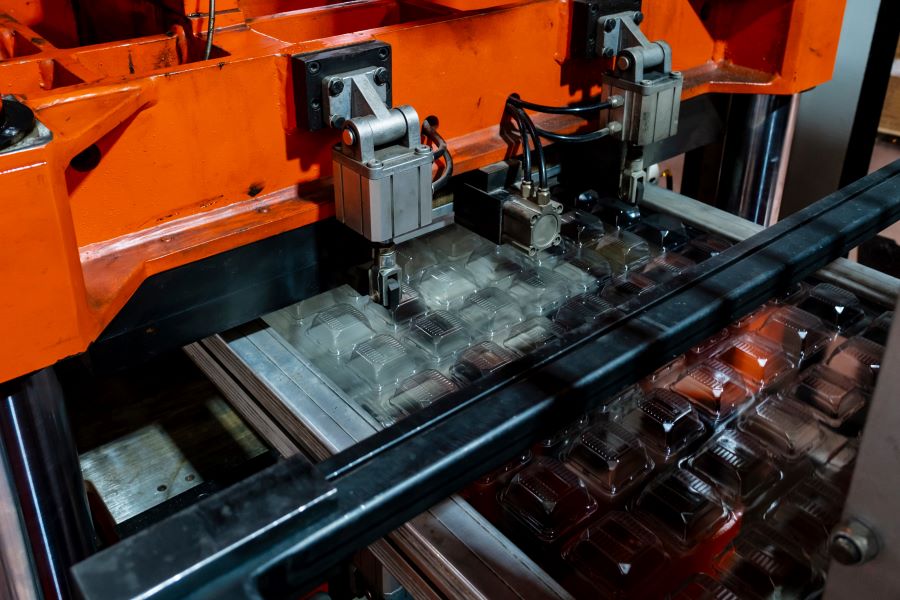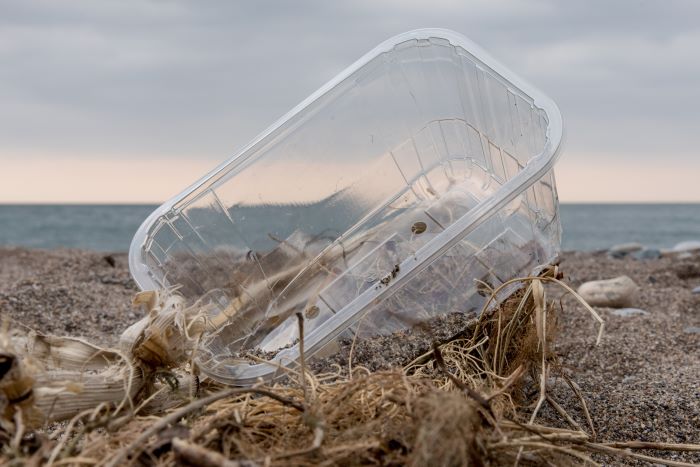Increasing the Circularity of #1 Plastic (PET) Recycling
Here’s a trick question. Can #1 plastics — otherwise known as PET (polyethylene terephthalate) plastics — go in the recycling bin?
Bet you thought the answer was yes. That’s only half right. It’s a trick question because the answer’s complicated. Most curbside recycling programs accept #1 plastics for recycling, but only certain forms of it. Bottles that hold various products—shampoo, salad dressing, water, and soda — are almost always accepted. Other types of #1 plastic containers — made by a method called thermoforming — are not accepted or used in the recycling stream.
That may be about to change.
What Is Thermoforming?
Thermoforming is a method of creating packaging by stretching a heated sheet of plastic over a mold to make a desired shape. Clamshell containers — which have a hinged side similar to clams — are one common type of thermoformed packaging. These containers are used to package salad greens, berries, cherry tomatoes, bakery items, egg cartons, and more. They cannot be recycled with PET bottles because the two types of plastic, although both categorized as #1 plastic, are chemically different and melt at different temperatures.
As far as plastic packaging goes, thermoformed packaging isn’t all bad. It:
- Is lightweight.
- Can protect food from going to waste (food waste is a major climate change culprit). It’s also used for packaging blisters, medical packaging, and many other types of packaging.
- Is recyclable.
- Can be made with recycled PET (rPET) as well as a variety of other polymers.
If we could recover more thermoform packaging and add it to the recycling stream, it would represent a positive step toward reducing waste and the need for drilling more oil to support our packaging needs.
There’s a growing demand for recycled PET, especially in the textile industry, which uses it to make polyester. If we can introduce efficient recycling technology, those thermoformed #1 plastic clamshells do have value.

Current Stats on Recycling Plastic PET
Even though it is highly recyclable, the recycling rates for PET plastic packaging are disappointing. Lack of access to recycling systems and low participation among consumers and businesses contribute to poor recycling rates.
As of 2020:
- PET plastic bottles have a recycling rate of about 27%, even though most curbside recyclers accept those items.
- Only 54% of Americans have access to recycle thermoformed PET plastics such as egg cartons and fruit containers.
- Only 9% of thermoformed PET plastics are recycled.
That means that way too much recoverable PET plastic is taking up space in our landfills or incinerated. At the same time, more oil is needed to make virgin plastics used in packaging.
Challenges of Recycling PET Thermoform Packaging
There are challenges to recycling PET thermoform packaging, which is why it often goes to waste. These are some of the problems:
- In contrast to PET plastic bottles, there is no deposit on food packaging, so it’s solely up to the consumer to recycle.
- Adhesives used for labels don’t separate from containers and gum up recycling machinery.
- Paper labels mix in with the PET plastic.
- Thermoformed plastics have less viscosity and are more brittle, making these plastics unsuitable for bottle production. So it’s essential to separate thermoformed PET from other PET containers when recycling.
- Not all materials recovery facilities have sorting equipment that can separate thermoformed packaging from other plastics.
- Consumer confusion about whether thermoformed plastics can go in curbside bins.
None of this means we can’t do better. In fact, there is an array of stakeholders working to improve the circularity of PET packaging.
Working Towards Closed-Loop Recycling of PET Thermoform Packaging
A few years ago, Driscoll’s, the berry company, recognized the lost opportunities of thermoform-to-thermoform recycling. In collaboration with packaging suppliers, a materials recovery facility (MRF), and other industry brands, Driscoll’s became part of The Alliance for PET Thermoform Recycling to remove barriers to thermoform recycling.
In 2021, Driscoll’s and their suppliers achieved a 9% rate of rPET thermoform packaging in their clamshell packaging. Before then, their suppliers used rPET from bottles, but not from thermoform packaging. (Overall, Driscoll’s clamshells use about 80% rPET — including 40% pre-consumer content, 30% rPET from bottles, and 21% virgin plastic.)
The success of this type of material-specific collaboration may serve as a model for other challenging materials in the recycling stream.
Solutions
Another collaboration comes from The Recycling Partnership. In June 2022, it launched its PET Recycling Coalition, which is working to improve the circularity of PET recycling. Its purpose is to create “scalable solutions to packaging and system challenges” and accelerate “the shift to a circular economy that uses fewer finite resources.”
As stated on its website, the Recycling Partnership’s plans include:
- Increasing PET capture rates by upgrading the efficiency of the recycling system
- Optimizing the flow of recycled PET by technology and infrastructure updates at sortation facilities and PET reclaimers
- Bolstering PET recycling through expanded access and effective messaging in local recycling programs

How Consumers Can Support PET Circularity
The success of PET circularity initiatives will come largely from industry and infrastructure. But you can play a role, too.
Send a message that you prefer sustainable alternatives. Buy products made with recycled #1 plastics or biodegradable packaging. When you are shopping, read the package to see if it’s made from recycled content. If brands put in the effort and expense to source rPET, they’ll let you know. Look for the term “post-consumer content” and a percentage.
Call your recycling company and see which #1 plastics they accept. It’s tempting to toss everything with a #1 on it in the bin. If the company doesn’t accept it, though, that’s called wish-cycling and can do more harm than good.
Do your bit by sorting plastics at home and ensuring they are clean and dry when placed in your recycling bin. Be careful not to put thermoformed plastics in the bin if your recycling system does not accept them. But there may be a store or other location where you can drop off these plastics for recycling. Ask your local recycler and also search the Earth911 database for a drop-off location near you. Nothing happens in our recycling system until you take the first step.
Support extended producer responsibility (EPR) legislation at state and local levels. EPR programs can include deposit and incentive programs that make it profitable to collect recyclables. Take the time to ask your local waste management office to add comprehensive recycling for all plastics, not just #1 plastic.


